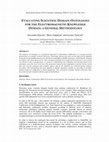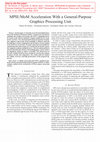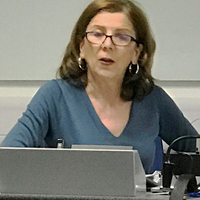Papers by alessandra esposito
Semantic frameworks are more and more used to access knowledge and to enhance cooperation in scie... more Semantic frameworks are more and more used to access knowledge and to enhance cooperation in scientific research. An increasing need of resource sharing and integration is coming out in the electromagnetic domain as well. This paper provides a proposal for an electromagnetic ontology framework, designed with the objective of maximizing knowledge reusability and integrability. It follows a modular, layered architecture, based on a robust sharable conceptualization, given by publicly available well-known top-level ontologies. The implementation of an ontology in the area of radiopropagation modeling is provided as specific example of practical application. Finally, the paper illustrates a simple example of reasoning, which demonstrates how the ontology supports advanced knowledge processing by simple query codification.
Novel Algorithms and Techniques in Telecommunications and Networking, 2009
Abstract-The continuous evolution of wireless networks, as well as the attention paid by the publ... more Abstract-The continuous evolution of wireless networks, as well as the attention paid by the public opinion to human exposure to electromagnetic fields radiated by basestation antennas, render the development of software tools to support optimum design and planning of 3G ...
2010 IEEE International Symposium on Industrial Electronics, 2010
Abstract This paper presents a proposal for a context-aware framework for alert generation. The f... more Abstract This paper presents a proposal for a context-aware framework for alert generation. The framework is organized according to a general purpose agent-based architecture, centered around an ontological context representation. The ontology provides the ...

International journal of Web & Semantic Technology, 2011
The adoption of ontologies as a formalized approach to information codification is a constant-gro... more The adoption of ontologies as a formalized approach to information codification is a constant-growing phenomenon in scientific research. Moreover, knowledge sharing and reuse can be improved by adopting hierarchical and modular frameworks and therein embedding available ontologies. Unfortunately, merging procedures may bring about severe, time-consuming problems if a careful selection process is not carried out. Based on these considerations, we propose a methodology for evaluating and selecting higher-level ontologies, given the lower-level ones. Our proposal is based on the computation of ad-hoc metrics which take into account structural and semantic aspects and on the adoption of a multi-decisional analysis procedure. The methodology has been applied to identify ontologies suitable for providing a scientific domain high-level codification to Electromagnetism. Two well-known scientific domain ontologies have been selected and evaluated with the proposed methodology.
IEEE Antennas and Propagation Magazine, 2014
This month's contribution addresses an important topic for all of us: how to improve the accuracy... more This month's contribution addresses an important topic for all of us: how to improve the accuracy of Internet-based literature searches. (At the time of writing, a human expert is still far more likely to provide a useful answer to a question such as, "What is the key reference in fi eld X," than an Inter net search engine). Whilst of course this topic is relevant to all fi elds of scientifi c enquiry, the authors have investigated this here in the specifi c context of electromagnetic engineering. Esposito and Tarricone's group at the University of Salento, Italy, have been regular contributors to this column, including the April 2003, October 2007, August 2009, and June 2010 issues. We thank their team for their continuing and compel ling contributions, which are always extremely stimulating in highlighting new avenues of exploration.
Lecture Notes in Computer Science (including subseries Lecture Notes in Artificial Intelligence and Lecture Notes in Bioinformatics), 2011
In this paper, we propose the use of graphics processing units as a low-cost and efficient soluti... more In this paper, we propose the use of graphics processing units as a low-cost and efficient solution of electromagnetic (and other) numerical problems. Based on the software platform CUDA (Compute Unified Device Architecture), a solver for unstructured sparse matrices with double precision complex data has been implemented and tested for several practical cases. Benchmark results confirm the validity of the proposed software in terms of speed-up, speed and GPU execution time.
Advances in Information Technologies for Electromagnetics
ABSTRACT
1996 IEEE MTT-S International Microwave Symposium Digest
A new strategy based on combinatorial optimization of the port numbering in combination with the ... more A new strategy based on combinatorial optimization of the port numbering in combination with the mode matching method has been developed for the fullwave analysis of complex networks. The approach has been implemented on both serial and parallel platforms and is shown to provide excellent efficiency (more than 20 times of speedup) overcoming the limitations of previous approaches based on

Character Recognition Technologies, 1993
Automatic understanding of line drawings is a fundamental task in order to feed a Geographic Info... more Automatic understanding of line drawings is a fundamental task in order to feed a Geographic Information System. Furthermore, the amount of alphanumeric data in engineering drawings and maps makes it necessary to automatically process characters and to provide efficient interactive tools for recognition validation. In this paper, we present the character recognition subsystem implemented within a larger system for the automatic interpretation of Italian cadastral maps (A0 format monochrome drawings representing land properties by means of continuous lines, dashed lines, shading patterns, characters, and special symbols). The system relies upon quite general methodologies, and experiments are now in progress on different kinds of line drawings. The character recognition subsystem consists of a sequence of steps -- from the detection of characters within the raster image to the reconstruction of text strings by grouping single characters, from character recognition to the placement of recognized texts in the vector image. Fully automatic steps are followed by interactive sessions, during which an operator checks and corrects the results provided by the system. The system is currently running on two different platforms: (1) S/370 or S/390 architecture running VM/CMS, equipped with IBM 5080 graphic stations, (2) IBM RS/6000 workstation running AIX.

Journal of Medical Systems, 2011
Along with the growing of the aging population and the necessity of efficient wellness systems, t... more Along with the growing of the aging population and the necessity of efficient wellness systems, there is a mounting demand for new technological solutions able to support remote and proactive healthcare. An answer to this need could be provided by the joint use of the emerging Radio Frequency Identification (RFID) technologies and advanced software choices. This paper presents a proposal for a context-aware infrastructure for ubiquitous and pervasive monitoring of heterogeneous healthcare-related scenarios, fed by RFID-based wireless sensors nodes. The software framework is based on a general purpose architecture exploiting three key implementation choices: ontology representation, multi-agent paradigm and rule-based logic. From the hardware point of view, the sensing and gathering of context-data is demanded to a new Enhanced RFID Sensor-Tag. This new device, de facto, makes possible the easy integration between RFID and generic sensors, guaranteeing flexibility and preserving the benefits in terms of simplicity of use and low cost of UHF RFID technology. The system is very efficient and versatile and its customization to new scenarios requires a very reduced effort, substantially limited to the update/extension of the ontology codification. Its effectiveness is demonstrated by reporting both customization effort and performance results obtained from validation in two different healthcare monitoring contexts.
International Journal of Web and Grid Services, 2008
284 Int. J. Web and Grid Services, Vol. 4, No. 3, 2008 ... A proposal for an electromagnetic onto... more 284 Int. J. Web and Grid Services, Vol. 4, No. 3, 2008 ... A proposal for an electromagnetic ontology framework ... Alessandra Esposito*, Luciano Tarricone, Laura Vallone and Marco Zappatore ... University of Salento, Lecce, Italy E-mail: alessandra.esposito@unile.it E-mail: luciano. ...
International Journal of Metadata, Semantics and Ontologies, 2012
The internet of things promises to embed objects within internet, by providing location and searc... more The internet of things promises to embed objects within internet, by providing location and search services, by integrating sensor data, user input and stored information. All this is going to be implemented with the support of a processing layer, which is distributed over the network and assures a smart behaviour, exhibited at a global and a local level. Given these premises, this paper explores different aspects connected to smartness, such as identification, representation and intelligence, both individual and collective. Contact points of the internet of things with semantic web and other initiatives, coming from the social web and business and research activities, are explored in a sort of journey through open challenges and achievements from related areas which are worth to be exploited.
International Journal of Autonomous and Adaptive Communications Systems, 2010
This paper presents a proposal for a context-aware framework. The framework is organised accordin... more This paper presents a proposal for a context-aware framework. The framework is organised according to a general purpose architecture, centred around an ontological context representation. The ontology provides the vocabulary upon which software agents interoperate and perform rule-based reasoning, in order to determine the system response to context changes. Context data are provided by both static and dynamic sources, the core of which is a novel low-cost device enabling the integration of sensor networks with RFID systems. This paper describes system components and their coordinated operations by providing a simple example of concrete application in a home-care scenario.

IEEE Transactions on Microwave Theory and Techniques, 2012
In this paper, we describe an accelerated implementation of the Method of Moments (MoM). A framew... more In this paper, we describe an accelerated implementation of the Method of Moments (MoM). A framework is proposed, exploiting the graphics processing unit (GPU) computing power by means of the software platform compute uni¿ed device architecture (CUDA). The mixed-potential integral-equation formulation, applied to microstrip circuit modeling, is adopted, and both the impedance matrix computation and the linear system solution of the MoM are accelerated. The latter point has been handled by considering both a direct dense (LU-based) and an iterative sparse (bi-conjugate gradient stabilized) solver. The best suited method is selected automatically during a thresholding phase, which renders the impedance matrix as sparse as possible. The effectiveness of the GPU-enabled MoM has been extensively tested in the analysis of planar circuits and components. The results achieved con¿rm the validity, accuracy, and high performance of the proposed approach. Index Terms-Graphics processing unit (GPU), method of moments (MoM), mixed-potential integral-equation (MPIE), NVIDIA compute uni¿ed device architecture (CUDA), planar microstrip circuits.
IEEE Antennas and Propagation Magazine, 2009
S IX years ago, the April 2003 column introduced grid computing to our readers. In the authors ' ... more S IX years ago, the April 2003 column introduced grid computing to our readers. In the authors ' April 2006 contribution, many of the ideas were extended , focusing on semantic grids, which added some degree of intelligence to the grid in terms of availability of resources (both hardware and software) for a particular task. In the October 2007 column , the use of ontologies in the field of knowledge modeling was discussed. In this issue, the authors provide a continuing update on their very stimulating work on applying new concepts in IT within computational electromagnetics. The topic of this issue's column is the use of software agents in the context of grid computing, for an application in optimum 3G network planning.
Recherche, 2004
Today, more and more practitioners, researchers, and students are utilizing the power and efficie... more Today, more and more practitioners, researchers, and students are utilizing the power and efficiency of grid computing for their increasingly complex electromagnetics applications. This cutting-edge book offers you the practical and comprehensive guidance you need to ...
COGNITIVE 2011, The Third …, 2011
Abstract: Nowadays ontologies represent a largely adopted information codification technique in m... more Abstract: Nowadays ontologies represent a largely adopted information codification technique in many knowledge domains. Complex ontological frameworks have been developed in diverse areas, presenting the association of different levels of logic and ...
In this paper, we present a GPU-based algorithm which accelerates the MoM impedance matrix comput... more In this paper, we present a GPU-based algorithm which accelerates the MoM impedance matrix computation. Based on an efficient quasi-one-dimensional approximation of the reaction integrals, the MPIE formulation for the analysis of microstrip circuits is considered. We use NVIDIA CUDA as GPU development tool and choose an edge-connected line-fed patch antenna as reference problem. In order to demonstrate the validity of our work, we first show how the results provided by the GPU implementation, the corresponding CPU code and a well-known commercial simulator are indistinguishable. Second, we conduct a performance analysis that proves how the developed algorithm running on a cheap off-the-shelf GPU is about 17 times faster than the CPU code.











Uploads
Papers by alessandra esposito